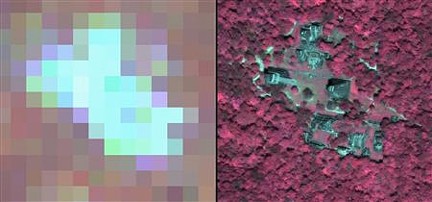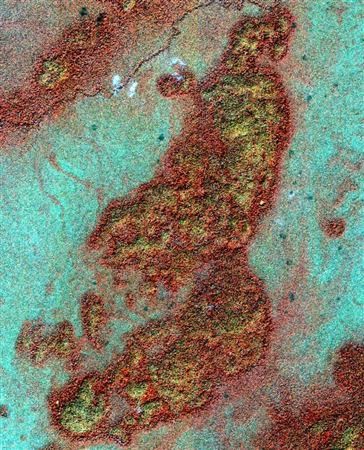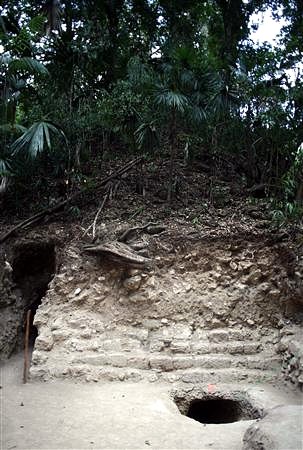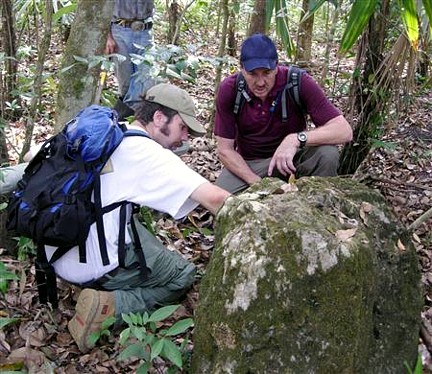Los satélites sacan a la luz varios templos mayas perdidos

Fotos: Templos mayas al descubierto. En esta imagen comparativa, tomadas desde el espacio por dos satélites, se ven las ruinas de Tikal, una ciudad maya ubicada en las profundidades de la selva guatemalteca. REUTERS/NASA/Handout.
Arqueólogos y científicos de la NASA, con la ayuda de satélites, han descubierto varios sitios escondidos durante siglos bajo la tupida selva de Guatemala.
Los antiguos astrólogos mayas alinearon sus templos con las estrellas y ahora los arqueólogos modernos han encontrado las ruinas de ciudades escondidas en la selva de Guatemala desde el cielo. Los arqueólogos y los científicos de la NASA se unieron hace cinco años en busca de las claves acerca del misterioso colapso de la civilización maya, que floreció en Centroamérica y el sur de México durante 1.000 años, antes de abandonar sus ciudades misteriosamente hacia el año 900 después de Cristo.
Y esa unión está dando frutos, según el arqueólogo William Saturno, quien descubrió recientemente cinco sitios extensos, con centenares de edificios, utilizando un satélite espía que puede ver a través de nubes y bosques para revelar las sutiles diferencias en la vegetación. Saturno informó que las imágenes de satélite facilitaron enormemente el hallazgo de las ruinas, cubiertas por siglos de densas enredaderas y árboles. La idea inicial del arqueólogo era buscar primero las imágenes del satélite para encontrar la fuente del agua cerca de su campamento de excavación en San Bartola, unos 53 kilómetros de la población más cercana.
La NASA le dio una foto de radiación solar reflejada sobre la gran variedad de plantas de la región y la gran sorpresa de Saturno fue ver un patrón de decoloración en la imagen que mostraba el contorno de algunos edificios que su equipo había descubierto. Utilizando un aparato de GPS, marcó en un mapa las ubicaciones de otras decoloraciones cercanas y encontró una zona de arquitectura maya que no había sido descubierta.

Foto: REUTERS/NASA/Handout.
Los mayas construían con piedra caliza y estuco. A medida que los edificios abandonados se van desintegrando, los químicos de las piedras se mezclan con el suelo, impidiendo que algunas plantas crezcan alrededor de las estructuras o afectando la química de aquellas que sí pueden crecer. Los satélites pueden detectar las diferencias y el resultado es un mapa de las estructuras enterradas por la vegetación desde una distancia de 640 kilómetros de la Tierra.
El arqueólogo dijo que la foto le facilitó la búsqueda de los edificios que estaban escondidos desde hace siglos.
"Yo estaba como pescando en un barril," dijo Saturno en una entrevista. Con la nueva tecnología, Saturno ha encontrado cinco nuevos sitios cerca de San Bartolo con cientos de edificios.
Y espera más descubrimientos como el que hizo en 2001, cuando encontró un mural que data del año 100 antes de Cristo, describiendo el mito de la creación maya y una ceremonia real, lo que él llama la Capilla Sixtina del mundo maya.
Fuente: Reuters, Guatemala / El País.com, 21 de febrero de 2008
-
(2) Satellites spot lost Guatemala Mayan temples
By Brendan Kolbay
GUATEMALA CITY (Reuters) - Ancient Mayan astronomers aligned their soaring temples with the stars and now modern archeologists have found the ruins of hidden cities in the Guatemalan jungle by peering down from space.
Archeologists and NASA scientists began teaming up five years ago to search for clues about the mysterious collapse of the Mayan civilization that flourished in Central America and southern Mexico for 1,000 years.

Foto: REUTERS/NASA/Handout.
The work is paying off, says archeologist William Saturno, who recently discovered five sprawling sites with hundreds of buildings using a spy satellite that can see through clouds and forest to reveal differences in the vegetation below.
Saturno said the satellite images made it infinitely easier to find ruins covered for centuries by dense jungle vines and trees. "It was like shooting fish in a barrel," he said.
Saturno first sought out satellite images to find a source of water near his excavation camp at San Bartolo, which lies 32 miles from the nearest town on inaccessible roads deep in Guatemala's northern Peten region.
NASA gave him a snapshot of solar radiation reflected off the wide variety of plants in the region. Saturno was surprised to see a pattern of discoloration in the satellite image that outlined some of the buildings he had already uncovered.
Using a GPS device, he pinpointed on a map the location of other discolorations nearby and discovered several areas with hidden Mayan architecture.
The Maya built with limestone and lime plasters. As the abandoned buildings disintegrate, chemicals from the stones seep into the soil, keeping some plants from growing around the structures and affecting the chemistry of those that do grow.
The satellite can spot these differences and the result is a virtual road map of the buried structures from nearly 400 miles above Earth's surface.
CLUES TO COLLAPSE
Saturno said he expects more discoveries like his 2001 find of an elaborate mural from around 100 B.C. depicting the Mayan creation myth, dubbed the Sistine Chapel of the Mayan world.
His research partner at NASA, Tom Sever, hopes the satellite images could provide clues as to why the Mayan civilization collapsed around 900 A.D.
"What we are investigating is the choices the Maya made that ultimately created a catastrophic situation for them," Sever said by telephone from a NASA base in the U.S. state of Alabama.
To support a population boom the Maya felled huge swathes of jungle for agriculture. They collected water in giant reservoirs called "bajos" to farm during seasonal dry spells, but the deforestation raised temperatures and reduced rainfall, drying up water sources, Sever said.

Foto: REUTERS/NASA/Handout.
Bajos were found at around half the new sites located by the satellite, potentially boosting this theory of why the Maya had to leave their cities.
Information about the fate of the Maya could help modern societies make better choices and "avoid the sometimes disastrous mistakes of the past," said Sever. "We are in a race against time to preserve our history."
(Writing by Mica Rosenberg; Editing by Catherine Bremer and David Wiessler)
Source: Reuters, Wed Feb 20, 2008
8 comentarios
Gualberto Basaldua Aste -
ITALO -
ROBERTO CARLOS RAMON BARRADAS -
Byron -
Hatt -
Un saludo.
Alejandro -
Espero que con mejores técnicas se preserven mejor y se obtenga más datos que nos lleven a comprender este misterio del hombre.
THE MOES -
ERWIN -